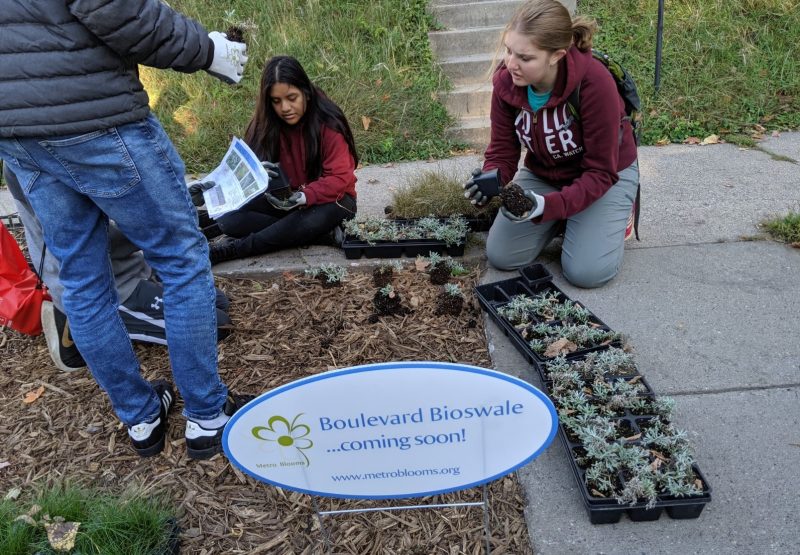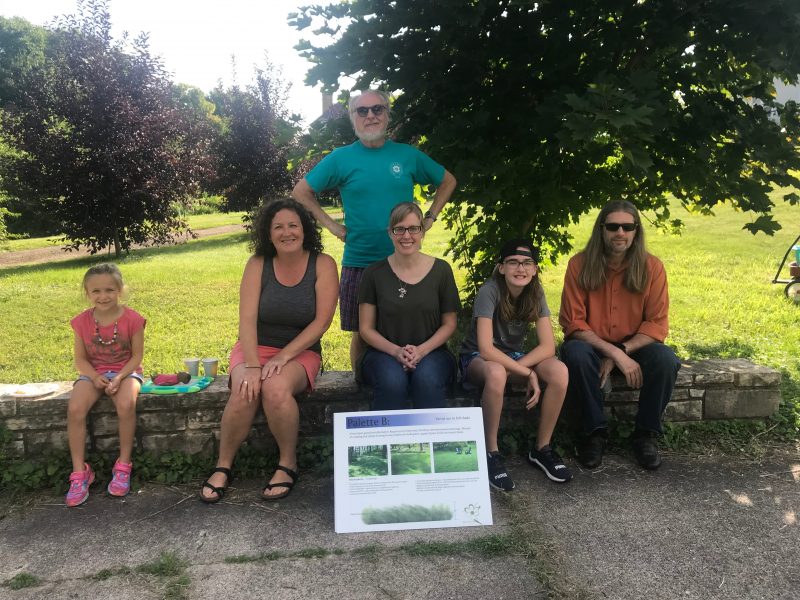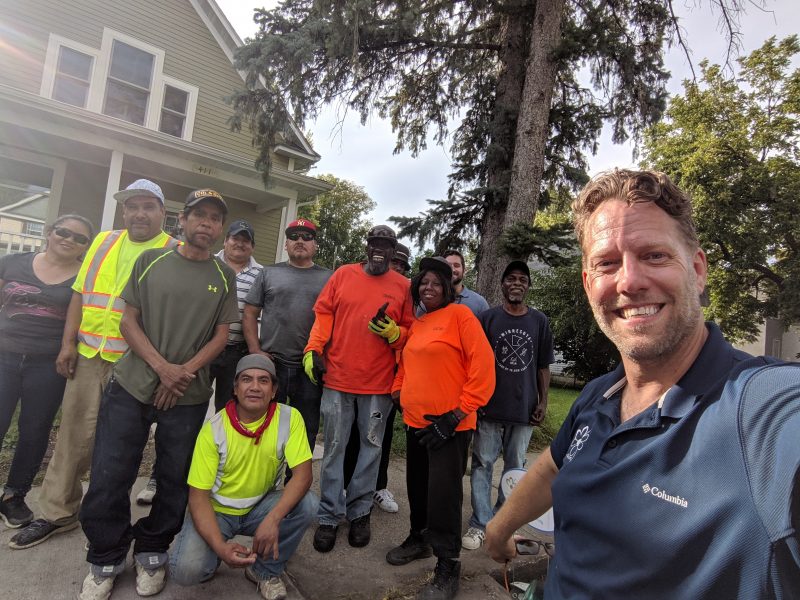When you walk through your neighborhood, it is not uncommon to see a tree, in a boulevard, marked with a big “X” in bright, neon-green paint. This green “X” indicates that the tree is an ash tree, a target of one of the nation’s most infamous insect pests, the emerald ash borer (EAB). This beetle, native to northeastern Asia, feeds on the bark of ash trees, killing the tree in one to four years. In Minneapolis, where greater than 20% of the tree canopy is composed of ash trees, the City of Minneapolis and Minneapolis Parks and Recreation Board (MPRB) are taking preventative measures to limit the spread of EAB by cutting down ash trees on public property. This translates to a loss of about 38,000 trees along Minneapolis streets.
Boulevard Bioswales: Improving Water Quality, Conserving Pollinators, Strengthening Communities
 The removal of ash trees presents a unique opportunity to reconsider boulevards, the little strips of vegetation between sidewalks and streets. Boulevards are generally planted with a tree and turfgrass, and aesthetics are typically valued more than ecosystem services in these plantings. They’re often mounded, blocking runoff rather than taking it in, due to soil buildup over time. At Metro Blooms, we are working with the City and Near North residents and community leaders to install boulevard bioswales in boulevards where ash trees are being removed. We excavate the boulevards slightly, lowering the grade, and put in native or well-adapted plants, creating mini-gardens that capture stormwater runoff, provide food for pollinators and beautify neighborhoods. Stormwater runoff is a leading cause of water pollution in our lakes and rivers, creating unfavorable conditions for wildlife and recreation. Metro Blooms believes that boulevard bioswales can turn this underutilized space into beautiful landscape features that contribute to a healthy ecosystem.
The removal of ash trees presents a unique opportunity to reconsider boulevards, the little strips of vegetation between sidewalks and streets. Boulevards are generally planted with a tree and turfgrass, and aesthetics are typically valued more than ecosystem services in these plantings. They’re often mounded, blocking runoff rather than taking it in, due to soil buildup over time. At Metro Blooms, we are working with the City and Near North residents and community leaders to install boulevard bioswales in boulevards where ash trees are being removed. We excavate the boulevards slightly, lowering the grade, and put in native or well-adapted plants, creating mini-gardens that capture stormwater runoff, provide food for pollinators and beautify neighborhoods. Stormwater runoff is a leading cause of water pollution in our lakes and rivers, creating unfavorable conditions for wildlife and recreation. Metro Blooms believes that boulevard bioswales can turn this underutilized space into beautiful landscape features that contribute to a healthy ecosystem.
 Metro Blooms partnered with community organizations to recruit resident participants, including the Harrison Neighborhood Association, Jordan Area Community Council, Hawthorne Neighborhood Council, and the Northside Residents Redevelopment Council (NRRC). Project participants received free one-on-one site consultations with a Metro Blooms landscape professional to select the plant palette that was best suited for their boulevard. Some participants even hosted block parties so that their neighbors could learn about the benefits of a boulevard bioswale and join the project. We held four block parties that recruited over a dozen participants, about one third of our total participants. Building stronger social connections between neighbors is an important aspect of this program, and creates more resilient communities overall.
Metro Blooms partnered with community organizations to recruit resident participants, including the Harrison Neighborhood Association, Jordan Area Community Council, Hawthorne Neighborhood Council, and the Northside Residents Redevelopment Council (NRRC). Project participants received free one-on-one site consultations with a Metro Blooms landscape professional to select the plant palette that was best suited for their boulevard. Some participants even hosted block parties so that their neighbors could learn about the benefits of a boulevard bioswale and join the project. We held four block parties that recruited over a dozen participants, about one third of our total participants. Building stronger social connections between neighbors is an important aspect of this program, and creates more resilient communities overall.
Choosing what to plant
Our sustainable landscape managers Mike Morrison and James Wolfin designed plant palettes that are easy to maintain and provide high-quality forage for pollinators. The palettes offered options that would allow plants to thrive under different sunlight and soil moisture conditions. Participants could choose between planted boulevards and seeded boulevards. Planted boulevards featured a mixture of diverse native grasses and wildflowers with deep root systems to absorb water and showy blooms to attract pollinators. Seeded boulevards contained a mixture of turfgrass and low-growing wildflowers that also support pollinators. These boulevards are especially hardy, able to grow even when exposed to salt and high foot traffic. The salt-tolerant turf mix was developed with the help of University of Minnesota turfgrass scientists. For flowers, early-season bloomers were mixed with late-season bloomers to ensure that food would be available to pollinators throughout the growing season.
Constructing the boulevards
 Metro Blooms collaborated with NEON (Northside Economic Opportunity Network) to hire local crews to construct the boulevard bioswales. Metro Blooms Director of Design Rich Harrison and Wolfin trained crew members in sustainable landcare practices and using machinery such as excavation and stump-grinding equipment. Crews lowered the boulevards to 3” below the grade of the curb and the sidewalk so that stormwater would flow from the sidewalk into the bioswale, reducing runoff.
Metro Blooms collaborated with NEON (Northside Economic Opportunity Network) to hire local crews to construct the boulevard bioswales. Metro Blooms Director of Design Rich Harrison and Wolfin trained crew members in sustainable landcare practices and using machinery such as excavation and stump-grinding equipment. Crews lowered the boulevards to 3” below the grade of the curb and the sidewalk so that stormwater would flow from the sidewalk into the bioswale, reducing runoff.
Planting
Next we planted. We had help from our Minnesota GreenCorps member Lilah White, youth crews from the Mississippi Green Team, a conservation and employment program through the Mississippi Watershed Management Organization and MPRB, and other volunteers. For seeded boulevards, we used a planting method called “dormant seeding,” spreading seeds at temperatures of about 40° Fahrenheit, when the ground is not yet frozen but is too cold for seeds to germinate. Come spring, the seeds will be ready to germinate as temperatures warm up. Then we covered the seeded boulevards with hydromulch to help plants retain moisture and protect against wind, water, and sun erosion. In the next couple of months, we’ll host trainings for participants to learn more about caring for their boulevards to ensure they look nice and work well for years to come.
Reflecting, summing up
In the winter, we invited project participants to a community outreach event to reflect on the program. Ella Weber, a PhD student from the University of Minnesota’s Center for Urban and Regional Affairs (CURA), used ripple effects mapping (REM), a collaborative evaluation technique, to lead participants in interviewing one another and sharing and organizing information. The results will help us improve the bioswales program in the future.
In total, 37 boulevard bioswales, covering over 6,000 square feet, were installed throughout North Minneapolis. Residential, commercial, municipal and institutional properties were all included in this project. The plantings are projected to capture nearly 300,000 gallons of water, 250 pounds of sediment, and 1 pound of phosphorus per year. Ten different species of flowers were planted to provide food for our much-needed pollinators. All in all, this project will help to improve water quality, protect pollinators, and beautify communities within North Minneapolis.
– James Wolfin, james@metroblooms.org